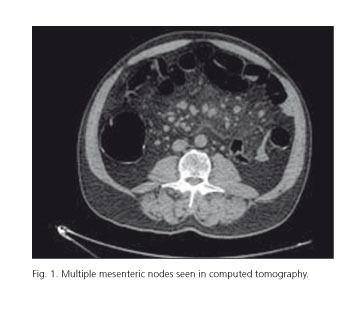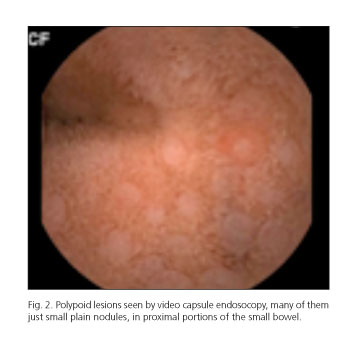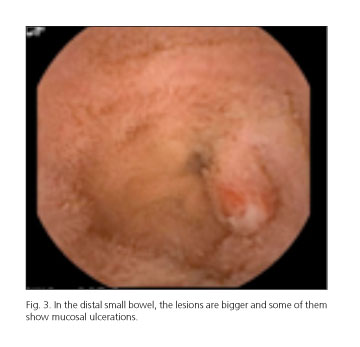My SciELO
Services on Demand
Journal
Article
Indicators
-
 Cited by SciELO
Cited by SciELO -
 Access statistics
Access statistics
Related links
-
 Cited by Google
Cited by Google -
 Similars in
SciELO
Similars in
SciELO -
 Similars in Google
Similars in Google
Share
Revista Española de Enfermedades Digestivas
Print version ISSN 1130-0108
Rev. esp. enferm. dig. vol.106 n.1 Madrid Jan. 2014
https://dx.doi.org/10.4321/S1130-01082014000100008
PICTURES IN DIGESTIVE PATHOLOGY
Diagnosis of follicular lymphoma of the small bowel by video capsule endoscopy
Diagnóstico de linfoma folicular de intestino delgado mediante videocápsula endoscópica
Juan Egea-Valenzuela, José Manuel Castillo-Espinosa, Antonio Sánchez-Torres, Fernando Alberca-de-las-Parras and Fernando Carballo Álvarez
Department of Gastroenterology. Hospital Clínico Universitario Virgen de la Arrixaca. Murcia, Spain
Introduction
Follicular lymphoma is one of the most common types of non-Hodgkin lymphoma in western countries. It is usually a silent disease and gastrointestinal location is rare, including less than 4 % of all non-Hodgkin lymphomas of the digestive tract. Endoscopy of the small bowel carried out with video capsule is useful for the diagnosis of this entity.
Case report
A 61 year-old asymptomatic male was included in the colorectal cancer screening programme. As fecal occult blood tests were positive, a colonoscopy was carried out, but the examination was not complete due to low tolerance to the procedure. Following the established protocol in our center a colonography by computed tomography (CT-colonography) was made. Colonic lesions were not observed but multiple mesenteric lymph nodes were diagnosed instead (Fig. 1). After this, a positron emission tomography (PET) described multiple abdominal nodes with enhanced metabolism. With the clinical suspicion of a lymphoproliferative process, we decided to carry out an endoscopic examination of the small bowel with video capsule in which we observed an amount of whitish nodules and small polipoid lessions (Fig. 2), located between the medium portion of jejunum and ileon. In the distal portions of the small bowel, the lesions were bigger, with thickened mucosal folds, and some of these nodules were ulcerated (Fig. 3). According to the reports in literature, these findings suggested a lymphoproliferative disorder of the small bowel (1). The specimens obtained by enteroscopy and CT-guided fine-needle aspiration confirmed the diagnosis of studium IIA follicular lymphoma.
Discussion
Although gastrointestinal follicular lymphoma is rare, the digestive tract is the most frequent extranodal location for this type of non-Hodgkin lymphoma. Development of small bowel endoscopy, with the use of video capsule and the different modalities of enteroscopy, has brought to a better diagnosis of this entity, and a more efficient follow-up of these patients after chemotherapy (2-4). In scientific literature, we only find descriptions of isolated cases or short series reports, but these works have made possible to define the most common aspect of these lesions on the intestinal mucosa, and establish an endoscopic differential diagnosis with other entities as different types of enteritis and other kinds of lymphoma (1,3,4).
References
1. Esaki M, Matsumoto T, Nakamura S, Suekane H, Ohji Y, Yao T, et al. Capsule endoscopy findings in intestinal follicular lymphoma. Endoscopy 2007;39:E86-7. [ Links ]
2. Akamatsu T, Kaneko Y, Ota H, Miyabayashi H, Arakura N, Tanaka E. Usefulness of double balloon enteroscopy and video capsule endoscopy for the diagnosis and management of primary follicular lymphoma of the gastrointestinal tract in its early stages. Dig Endosc 2010;22:33-8. [ Links ]
3. Sapoznikov B, Morgenstern S, Raanani P, Aviram A, Rabizadeh E, Prokocimer M, et al. Follicular lymphoma with extensive gastrointestinal tract involvement: Follow-up by capsule endoscopy. Dig Dis Sci 2007;52:1031-5. [ Links ]
4. Van Deursen CT, Goedhard JG, Jie KS, Theunissen P. Primary intestinal follicular lymphoma diagnosed by VCE and DBE. Endoscopy 2008;40(Supl. 2):E8-9. [ Links ]











 text in
text in 





